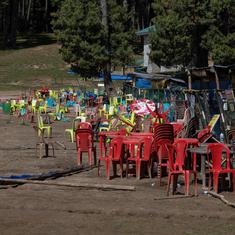Call Me Francis, the four-part fictional miniseries about Pope Francis, began life as an Italian film that had its world premiere at the Vatican in 2016. That is hardly surprising, since the miniseries chooses to paper over many of the accusations that have been hurled at the head of the Catholic Church relating to his time as a priest in Argentina.
The miniseries, currently streaming on Netflix, begins with a young Jorge Bergoglio, played stirringly by Rodrigo de la Sarna, in Buenos Aires in the 1960s. This was perhaps the last uncomplicated time in the future Pope’s life, as he spent carefree evenings with friends and debated whether to commit to a life of bachelorhood. An interesting subplot involves his time as a school teacher of literature during which he invited Jorge Luis Borges to lecture to his students.
Bergoglio was ordained a priest in 1969 and made Provincial, the head of the Jesuits in Buenos Aires, in 1973. The series pays close attention to the aftermath of his ascension as Provincial, a time that coincided with the “Dirty War” unleashed by the military dictatorship under the leadership of General Videla. Numbers vary, but close to 30,000 people “disappeared” in the period between 1974 and 1982. Apart from dissidents and left-wing political figures, the military abducted a motley group of people who it believed were undermining its interests.
Orlando Yorio and Francisco Jalics, Jesuit priests under the protection of Bergoglio, were suspected by the military of fomenting Marxist ideology among the poor they worked with. The two were kidnapped and tortured in detention before being dropped from helicopters in the outskirts of Buenos Aires. The other story the series focuses on pertains to Esther Careaga, whose daughter disappeared and who happened to be Bergoglio’s boss at the chemical technology company he was employed with before becoming a priest. She was drugged and thrown into the sea.
While the series presents both these incidents, it chooses to give Bergoglio the benefit of the doubt. In the case of the priests, it showcases how Bergoglio tried reasoning with them, in vain, to focus on pastoral work. Its treatment of Esther’s case is more brutal, both in capturing in shocking detail her final journey and in delineating Bergoglio’s inability to do anything to assist her. Yet, the series ultimately presents Bergoglio as a sympathetic figure, even at the cost of authenticity.
In one scene, Bergoglio is shown spotting Esther, after she disappeared, walking in a daze on the streets of Buenos Aires. He calls out to her but she does not respond. He bursts into tears, and the viewer feels a pang of empathy for him. In reality, however, Esther died at sea. Bergoglio refused to name the assailants of his Jesuit protégés in a 2010 testimony on the crimes committed during the Dirty War.
Pope Francis’s silence during a horrific time in his country’s history remains an open wound. Call Me Francis adds little to the conversation except for portraying its protagonist with a benevolence that is perhaps not earned.










